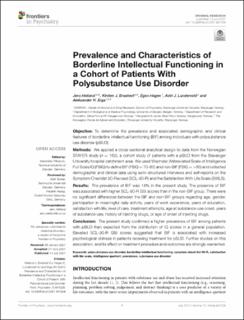| dc.contributor.author | Hetland, Jens | |
| dc.contributor.author | Braatveit, Kirsten | |
| dc.contributor.author | Hagen, Egon | |
| dc.contributor.author | Lundervold, Astri J. | |
| dc.contributor.author | Erga, Aleksander H. | |
| dc.date.accessioned | 2022-03-30T09:27:57Z | |
| dc.date.available | 2022-03-30T09:27:57Z | |
| dc.date.created | 2021-08-16T09:47:26Z | |
| dc.date.issued | 2021-07-14 | |
| dc.identifier.issn | 1664-0640 | |
| dc.identifier.uri | https://hdl.handle.net/11250/2988536 | |
| dc.description.abstract | Objective: To determine the prevalence and associated demographic and clinical features of borderline intellectual functioning (BIF) among individuals with polysubstance use disorder (pSUD).
Methods: We applied a cross-sectional analytical design to data from the Norwegian STAYER study (n = 162), a cohort study of patients with a pSUD from the Stavanger University hospital catchment area. We used Wechsler Abbreviated Scale of Intelligence Full Scale IQ (FSIQ) to define BIF (FSIQ = 70–85) and non-BIF (FSIQ = >85) and collected demographic and clinical data using semi-structured interviews and self-reports on the Symptom Checklist 90-Revised (SCL-90-R) and the Satisfaction With Life Scale (SWLS).
Results: The prevalence of BIF was 18% in the present study. The presence of BIF was associated with higher SCL-90-R GSI scores than in the non-BIF group. There were no significant differences between the BIF and non-BIF groups regarding age, gender, participation in meaningful daily activity, years of work experience, years of education, satisfaction with life, level of care, treatment attempts, age at substance-use onset, years of substance use, history of injecting drugs, or age of onset of injecting drugs.
Conclusion: The present study confirmed a higher prevalence of BIF among patients with pSUD than expected from the distribution of IQ scores in a general population. Elevated SCL-90-R GSI scores suggested that BIF is associated with increased psychological distress in patients receiving treatment for pSUD. Further studies on this association, and its effect on treatment procedure and outcomes are strongly warranted. | en_US |
| dc.language.iso | eng | en_US |
| dc.publisher | Frontiers | en_US |
| dc.rights | Navngivelse 4.0 Internasjonal | * |
| dc.rights.uri | http://creativecommons.org/licenses/by/4.0/deed.no | * |
| dc.title | Prevalence and Characteristics of Borderline Intellectual Functioning in a Cohort of Patients With Polysubstance Use Disorder | en_US |
| dc.type | Journal article | en_US |
| dc.type | Peer reviewed | en_US |
| dc.description.version | publishedVersion | en_US |
| dc.rights.holder | Copyright the authors 2021 | en_US |
| dc.source.articlenumber | 651028 | en_US |
| cristin.ispublished | true | |
| cristin.fulltext | original | |
| cristin.qualitycode | 1 | |
| dc.identifier.doi | 10.3389/fpsyt.2021.651028 | |
| dc.identifier.cristin | 1926177 | |
| dc.source.journal | Frontiers in Psychiatry | en_US |
| dc.identifier.citation | Frontiers in Psychiatry. 2021, 12, 651028. | en_US |
| dc.source.volume | 12 | en_US |

